Several indoor plants are known to grow well inside bathrooms. This is because bathrooms provide a natural tropical environment loved by many plants that require little to no sunlight.
Many bathrooms are windowless, so finding plants that require low lighting is the best option.
Thus, I have created a list that contains some of the most beautiful low-lighting plants that can be kept in bathrooms.
Table of Contents
30 Best Plants for Bathroom With No Light
- ZZ plant
- Spider plant
- Dumb cane plant
- Peace lilies
- Cast-iron plant
- Snake plant
- English ivy
- Arrowhead plant
- Pothos
- Heartleaf Philodendron
- Boston Fern
- Aglaonema
- Weeping Fig
- Calathea
- Aloe Plant
- Alocasia
- Bird’s Nest Fern
- Monstera
- Maidenhair Fern
- Oyster Plant
- Staghorn Fern
- Creeping Fig
- Baby Rubber Plant
- Lucky Bamboo
- Red Anthurium
- Kokedama
- Marimo
- Rex Begonia
- Dancing Bones Cactus
- Schefflera Soleil

Best Plants for Bathroom With No Light
1. ZZ Plant
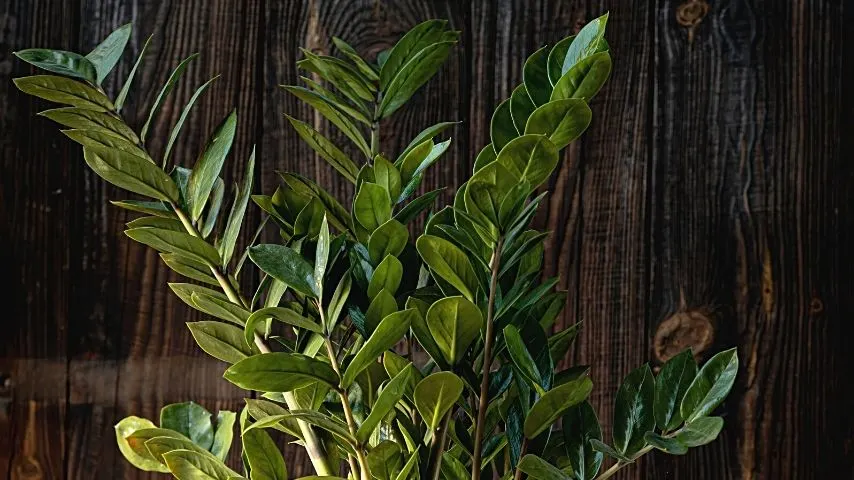
ZZ plants are known for their thick succulent stems and glossy foliage. This plant is considered almost indestructible because of its low demands and easy-care routine.
ZZ plants binomial nomenclature and basic plant care requirements include:
- Temperature: around 60° to 75°F (16°-to-24°C)
- pH: 0–7.0
- Soil: Needs Commercial potting soil
- Fertilizer: Needs balanced liquid houseplant fertilizer
- Growth rate: fast growth
- Humidity: 40% relative humidity
- Scientific name: Zamioculcas zamiifolia
- Family: Araceae
2. Spider Plant

Spider plants are low-maintenance plants that are suitable for pet-friendly environments.
They have been known to withstand attacks by the most infamous vegetation killers, and they look incredible when hung from a basket.
Spider plants are its binomial nomenclature and basic plant care requirements:
- Temperature: around 70° to 90°F (21°-to-32°C)
- pH: 6.1 to 6.5
- Soil: moist, loamy, and well-draining soil
- Fertilizer: Only needs fertilization in its growing season
- Growth rate: fast growth
- Humidity: 40% to 60%
- Scientific name: Chlorophytum comosum
- Family: Asparagaceae
3. Dumb Cane Plant

The Dumb Cane plant grows in many different varieties. It is toxic for cats and can cause side effects such as vomiting if ingested by cats.
The Dieffenbachia plant is native to Central and South America according to the University of Connecticut.
Dumb Cane plant binomial nomenclature and basic plant care requirements include:
- Temperature: around 60° to 80°F (16°-to-27°C)
- pH: 1 to 6.5
- Soil: Needs high peat content, and a well-draining potting mix
- Fertilizer: Needs to be fertilized with heavy fertilizer every four to six weeks
- Growth rate: fast growth
- Humidity: 40% relative humidity
- Scientific name: Dieffenbachia
- Family: Araceae
4. Peace Lilies
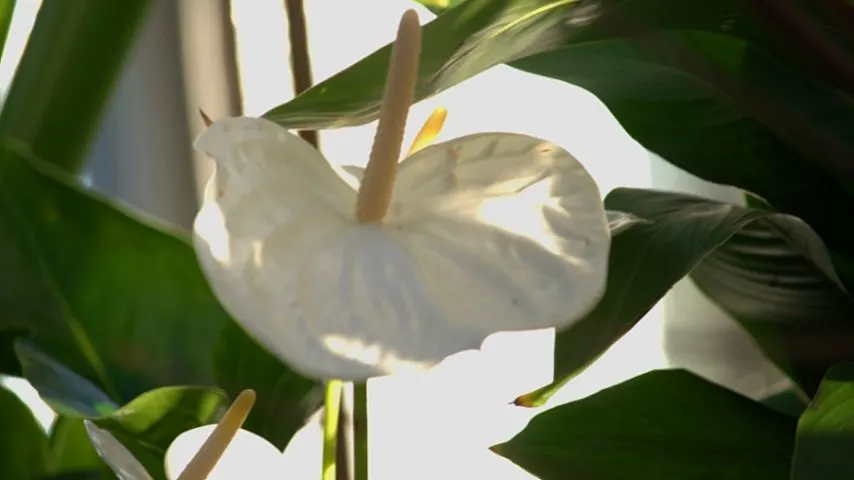
Peace lilies are beautiful flowering plants that grow stunning white spadix flowers. Peace lilies are very hardy plants requiring less maintenance.
Peace lilies binomial nomenclature and basic plant care requirements include:
- Temperature: around 65° to 85°F (18°-to-29°C)
- pH: 0 to 6.5
- Soil: Needs Moist but not soggy soil
- Fertilizer: Needs fertilization during the growing season with slow-release fertilizer
- Growth rate: fast growth
- Humidity: 40% to 70%
- Scientific name: Spathiphyllum
- Family: Araceae
5. Cast Iron Plant

Cast Iron is a simple yet elegant-looking plant grown for its stunning long-green leaves.
Cast Iron plant’s binomial nomenclature and basic plant care requirements include:
- Temperature: around 60° to 75°F (16°-to-24°C)
- pH: 5. to 6.5
- Soil: Needs organically rich soil
- Fertilizer: Needs liquid fertilizer during the spring and summer
- Growth rate: medium growth
- Humidity: 60% to 70%
- Scientific name: Aspidistra elatior
- Family: Asparagaceae
6. Snake Plant
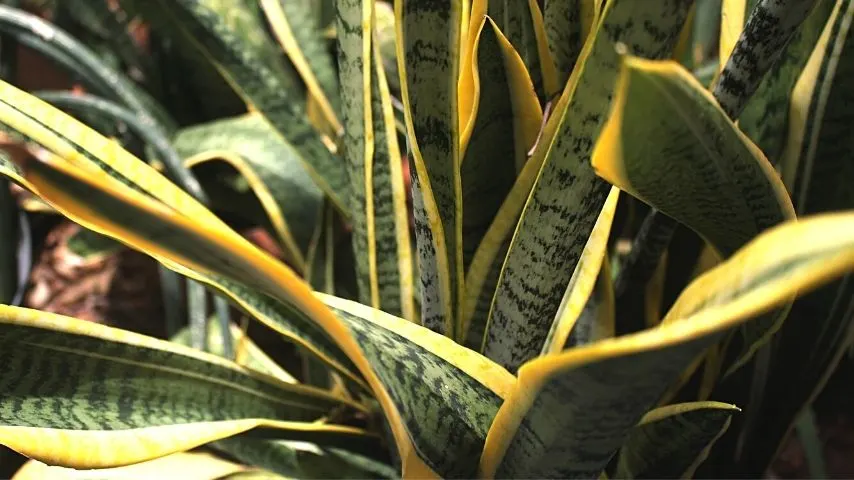
Snake plant is impossible-to-kill because it requires little to no maintenance.
This plant is thought to be the perfect gift for new houseplant enthusiasts or those who are unable to devote much time to their plants.
The snake plant’s binomial nomenclature and basic plant care requirements include:
- Temperature: around 55° to 85°F (13°-to-29°C)
- pH: 5 to 8.5
- Soil: Needs light loamy soil
- Fertilizer: is native to poor, rocky soil; thus, avoid overfertilizing by fertilizing in spring
- Growth rate: slow growth
- Humidity: 30% to 50%
- Scientific name: Dracaena trifasciata
- Family: Asparagaceae
7. English Ivy

English ivy is a climbing plant that is frequently planted outside on porches or near walls. Their tendency to trail up any sporting beam enables them to grow their leaves and freshen up any area.
English ivy plants binomial nomenclature and basic plant care requirements include:
- Temperature: 70° to 90°F (21°-to-32°C)
- Humidity: 40% or higher
- Scientific name: Hedera helix
- Family: Araliaceae
- Growth rate: Fast growth
- Fertilizer: Needs fertilization from spring to summer, every two weeks
- pH: 6.5 to 7.5
- Soil: Needs well-drained soil
8. Arrowhead Plant

The Arrowhead plant is a carpeting plant that requires little effort to grow. It has the appearance of grass and is nearly identical to miniature Vallisneria.
Arrowhead plant’s binomial nomenclature and basic plant care requirements include:
- Temperature: 64° to 79°F (17° to 26°C)
- Max height: 3-5 inches (8 to 12 cm)
- Care: easy
- Growth rate: Fast
- Fertilization: needs to be fertilized through root tabs and liquid fertilizers
- Common name: Floating Arrowhead, Needle Saggitaria, Narrow-leaved Arrowhead, and Awl-leaf Arrowhead
- Scientific name: Sagittaria Subulata
- Family: Araceae
9. Pothos

Pothos are stunning light-green leaved plants that are mostly grown in hanging baskets due to their long stems.
Pothos plants binomial nomenclature and basic plant care requirements include:
- Temperature: 70° to 90°F (21°-to-32°C)
- Fertilizer: Needs fertilization from spring to summer, once a month
- pH: 6.1 to 6.5
- Soil: requires nutrient-rich, well-draining soil
- Growth rate: Fast
- Humidity: 50-70%
- Scientific name: Epipremnum aureum
- Family: Araceae
10. Heartleaf Philodendron
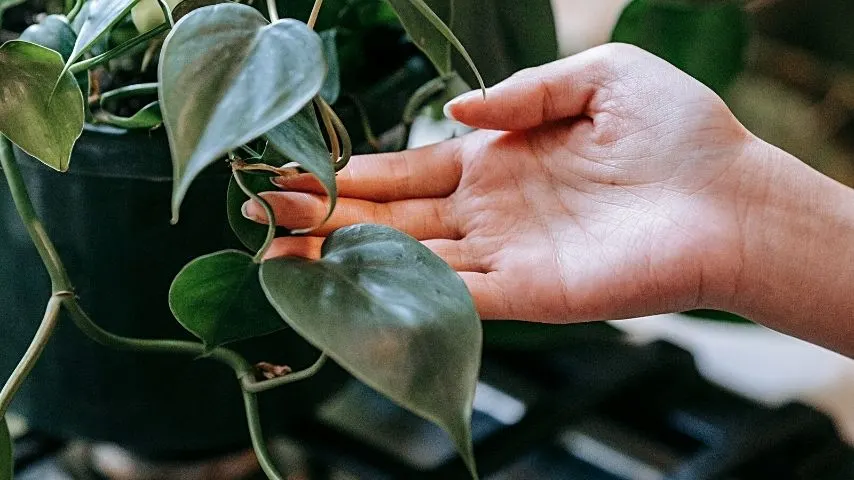
As its name suggests, Heartleaf Philodendron is a Philodendron plant that grows dark-green, heart-shaped leaves.
The foliage on this plant looks stunning as it is shiny and larger than the average plant.
Heartleaf Philodendron plant’s binomial nomenclature and basic plant care requirements include:
- Temperature: around 65° to 85°F (18°-to-29°C)
- pH: 5 to 6.0
- Soil: Needs Lightweight, fertile, well-drained
- Fertilizer: Needs fertilizer every 3-4 weeks during the active growing season
- Growth rate: fast to medium growth
- Humidity: 40% relative humidity
- Scientific name: Philodendron Heracleum
- Family: Araceae
11. Boston Fern

Boston fern is a plant in the fern family. This implies that when hung in baskets, this plant looks stunning.
Unlike other toxic fern plants, the Boston fern is non-toxic and low-maintenance.
Boston fern plants binomial nomenclature and basic plant care requirements include:
- Temperature: 65° to 95°F (18°-to-35°C)
- Fertilizer: requires fertilization once a month
- pH: 5.0 to 5.5
- Soil: requires loamy soil with compost mixed in
- Growth rate: Slow-growing
- Scientific name: Nephrolepis exaltata
- Family: Nephrolepidaceae
- Common names: also known as sword fern
12. Aglaonema

Aglaonema is a beautiful and unique plant that grows pink leaves with green edges. This plant grows slightly narrow, long leaves that can brighten up any bathroom.
Aglaonema plants binomial nomenclature and basic plant care requirements include:
- Temperature: around 70° to 85°F (21°-to-29°C)
- pH: 5.6-6.5
- Soil: Needs peat-based potting soil with extra Perlite
- Fertilizer: Needs an all-purpose fertilizer
- Growth rate: slow growth
- Humidity: 40% to 70%
- Scientific name: Aglaonema
- Family: Araceae
13. Weeping Fig

The weeping Fig is a small moisture-loving tree that has grown glossy dark green leaves. This shrub-like tree thrives in pots, as well as high humidity levels.
Weeping Fig plants binomial nomenclature and basic plant care requirements include:
- Temperature: around 60° to 85°F (16°-to-29°C)
- pH: 6.0 to 6.5
- Soil: Needs fast-draining potting soil
- Fertilizer: needs fertilizer that is rich in nitrogen
- Growth rate: fast growth
- Humidity: 50% to 70%
- Scientific name: Ficus Benjamina
- Family: Moraceae
14. Calathea

Calathea is another low-maintenance plant that is suitable for households with pets. The foliage is the most beautiful part because of the unique patterns on them.
Calathea plants binomial nomenclature and basic plant care requirements include:
- Temperature: 60° to 85°F (16°-to-29°C)
- Fertilizer: requires monthly fertilization in summer and spring
- pH: 6.5
- Soil: requires moist but not wet soil
- Growth rate: slow-growing
- Scientific name: Calathea
- Family: Marantaceae
- Common names: Prayer plants, peacock plants, rattlesnake plants, and zebra plants
15. Aloe Plant

Aloe vera is a succulent plant and contains a gel-like substance within its foliage which provides numerous benefits.
Aloe is toxic to cats and dogs. It can cause diarrhea, vomiting, and other symptoms if consumed.
Aloe vera plants’ binomial nomenclature and basic plant care requirements include:
- Temperature: 55° to 80°F (13°-to-27°C)
- Fertilizer: Once every six to twelve months is fine, but it is not needed
- pH: 4.5 to 5.5
- Soil: requires a mix of Perlite, lava rock, and chunks of bark
- Growth rate: it is slow-growing but grows faster than other succulents
- Humidity: does not require humidity
- Scientific name: Aloe vera
- Family: Asphodelaceae
16. Alocasia
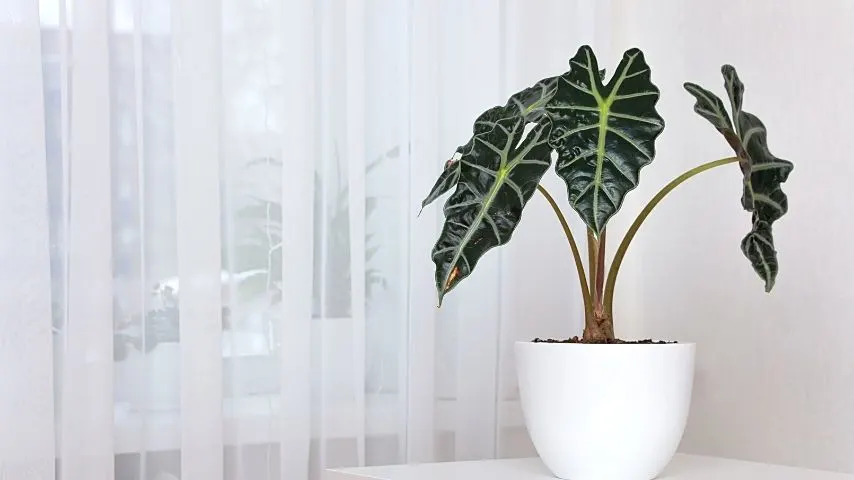
Alocasia is a stunning plant that thrives in high humidity levels. They are grown for their enormous leaves that catch your attention the second you enter a room.
Alocasia plant’s binomial nomenclature and basic plant care requirements include:
- Temperature: around 60° to 85°F (16°-to-29°C)
- pH: 5 to 6.5
- Soil: Needs crumbly loam or a well-draining and loose potting mix
- Fertilizer: Needs All Purpose Fertilizer
- Growth rate: moderate to fast growth
- Humidity: 50% to 60%
- Scientific name: Alocasia
- Family: Araceae
17. Bird’s Nest Fern

Bird’s Nest Fern is another eye-catching plant grown for its long and narrow green leaves. It looks beautiful when planted indoors in small pots.
Bird’s Nest Fern plants binomial nomenclature, and basic plant care requirements include:
- Temperature: around 70° to 90°F (21°-to-32°C)
- pH: 5.0 to 5.5
- Soil: Needs an organic compost or potting mix with peat
- Fertilizer: Needs balanced liquid houseplant fertilizer
- Growth rate: fast growth
- Humidity: 30% to 50%
- Scientific name: Asplenium nidus
- Family: Aspleniaceae
18. Monstera
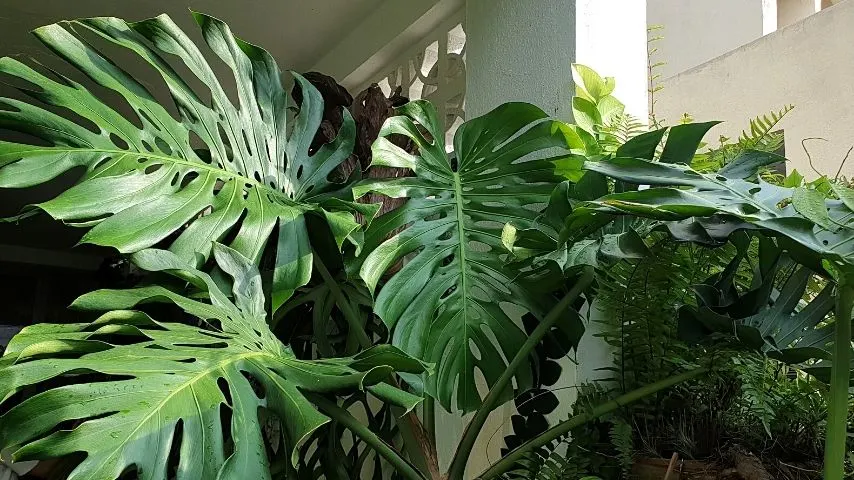
The Monstera plant, also known as the Swiss Cheese plant, is grown for its unique leaves that have holes in them.
Once the plant is mature, the hole within the leaves eventually expands out and creates fan-like foliage.
Monstera plants binomial nomenclature and basic plant care requirements include:
- Temperature: around 60° to 80°F (16°-to-29°C)
- pH: 5 to 7.0
- Soil: Needs soil mix rich in peat
- Fertilizer: needs fertilization once every 2 weeks and once monthly during its growing season
- Growth rate: moderate to slow growth
- Humidity: 60% to 80%
- Scientific name: Monstera deliciosa
- Family: Araceae
19. Maidenhair Fern
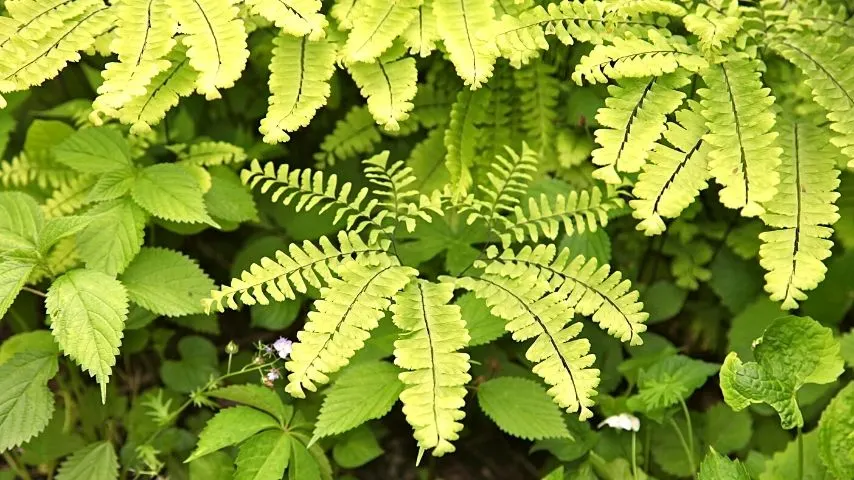
Maidenhair Fern is a gorgeous plant known for its clusters of small leaves. This plant looks stunning when placed on shelves inside smaller pots.
Maidenhair Fern plants binomial nomenclature and basic plant care requirements include:
- Temperature: around 60° to 70°F (16°-to-21°C)
- pH: 7.0 to 7.2
- Soil: Needs well-draining potting soil
- Fertilizer: not necessary to fertilize
- Growth rate: moderate to fast growth
- Humidity: 60% or more
- Scientific name: Adiantum
- Family: Pteridaceae
20. Oyster Plant
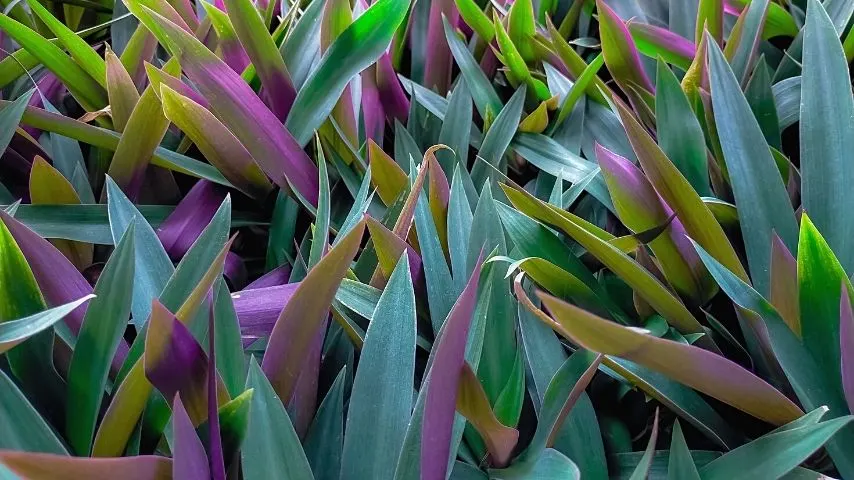
Oyster Plant is known for its beautiful purple and green leaves. It is medically used for treating nose-bleeds and sore throat.
Oyster Plant’s binomial nomenclature and basic plant care requirements include:
- Temperature: around 55° to 80°F (13°-to-27°C)
- pH: 1 to 6.5
- Soil: Needs Loamy, rocky, and well-drained soil
- Fertilizer: typically, not necessary to fertilize, but when needed, do it during the growing season
- Growth rate: fast growth
- Humidity: 40% relative humidity
- Scientific name: Tradescantia spathacea
- Family: Commelinaceae
21. Staghorn Fern

Staghorn Fern is a unique plant because of the leaves it grows. The leaves on Staghorn Fern do not have any specific shape to them, which adds a unique touch to your plant collection.
Staghorn Fern plants binomial nomenclature and basic plant care requirements include:
- Temperature: around 55° to 80°F (13°-to-27°C)
- pH: 5.7
- Soil: Needs an organic, well-draining planting medium
- Fertilizer: Needs balanced, water-soluble fertilizer
- Growth rate: slow growth
- Humidity: 40% and below
- Scientific name: Platycerium
- Family: Polypodiaceae
22. Creeping Fig

Creeping Fig is a climbing plant and will grow attached to walls or poles. It helps create a stunning green wall when planted on the ground but can be left hanging in baskets as well.
Creeping Fig plants binomial nomenclature and basic plant care requirements include:
- Temperature: around 65° to 85°F (18°-to-29°C)
- pH: 5 to 7.5
- Soil: Needs well-drained soil
- Fertilizer: Fertilize once a month in spring and summer using a balanced fertilizer
- Growth rate: fast growth
- Humidity: 50% relative humidity or higher
- Scientific name: Moraceae
- Family: Mulberry family
23. Baby Rubber Plant

Baby Rubber Plants may appear toxic to pets, but they are not. This small plant foliage is around two to four inches long and can grow about twelve inches wide.
Because this is not a fussy plant, you can easily take care of it. Baby Rubber plant’s binomial nomenclature and basic plant care requirements include:
- Temperature: around 65° to 85°F (18°-to-29°C)
- Fertilizer: Needs to be fertilized once a month or even bi-monthly
- Growth rate: Moderate growth rate
- pH: between 5.5 to 7.0.
- Soil: require nutrient-rich soil and well-draining soil
- Scientific name: Peperomia obtusifolia
- Family: Piperaceae
24. Lucky Bamboo

Lucky Bamboo is the most unique plant on the list because of the many shapes it can take. This plant will grow tall and can take many different shapes depending on how you grow it.
The Lucky Bamboo plant’s binomial nomenclature and basic plant care requirements include:
- Temperature: around 65° to 90°F (18°-to-32°C)
- pH: between 6.0 and 6.5
- Soil: Needs well-drained, rich potting soil
- Fertilizer: Needs a single drop of liquid fertilizer each month
- Growth rate: Slow to moderate growth
- Humidity: 50% relative humidity
- Scientific name: Dracaena Sanderiana
- Family: Asparagaceae
25. Red Anthurium

As the name suggests, Red Anthurium is a red flowering plant that is known for the shiny red spadix flowers that it grows.
This plant can grow as tall as 18 inches (45 cm) or be kept as a small plant that grows only 12 inches (30 cm).
Red Anthurium plant’s binomial nomenclature and basic plant care requirements include:
- Temperature: around 65° to 85°F (18°-to-29°C)
- pH: 5.5 to 6.5
- Soil: Needs coarse, well-draining potting soil
- Fertilizer: Needs one-quarter strength fertilizer once every three to four months
- Growth rate: Slow to moderate growth
- Humidity: 50% relative humidity or more
- Scientific name: Anthurium andraeanum
- Family: Araceae
- Common names: anthurium, tailflower, flamingo flower, and laceleaf
26. Kokedama

Kokedama is a unique planting style of using moss as the base for other plants. Koke means moss, while dama means ball. Many plants can be grown in a moss ball as long as they like a humid substrate.
It is the practice of growing moss as a ball. It is tied to the culture of growing bonsai.
Kokedama care:
- Temperature: around 60° to 85°F (16°-to-29°C)
- Soil: Needs indoor potting soil mixed with outdoor potting soil
- Fertilizer: Needs liquid indoor plant fertilizer during summer and spring
- Growth rate: moderate growth
- Humidity: 50% relative humidity
- Scientific name: Kokedama
27. Marimo

This plant is widely regarded as the quickest to cultivate on the list.
The Marimo Moss Ball plant appears to be a velvety green ball that is neither moss nor plant but instead a naturally existing cladophora algae ball.
Marimo is an aquarium plant but can be simply grown in a small fish ball. Marimo plants binomial nomenclature and basic plant care requirements include:
- Temperature: around 43° to 75°F (5°-to-24°C)
- Fertilizer: is not required
- Growth rate: fast growth
- Scientific name: Aegagropila Linnaei
- Family: Pithophoraceae
28. Rex Begonia

Rex Begonia is a stunning and unique plant grown for its crinkly-looking leaves. This plant can be found in colors ranging from gray to purple.
Usually, the foliage has a different color in the center and the edges. It also has dark veins on the leaves that make this plant stand out more than any other plant.
While it may not look like it, Rex Begonia’s are one of the easiest plants to take care of.
They can be grown in many different conditions, making them one of the best plants to grow in a bathroom under low lighting.
Rex Begonia plants binomial nomenclature and basic plant care requirements include:
- Temperature: around 60° to 75°F (16°-to-24°C)
- pH: 5.7 to 6.2
- Soil: requires porous fast-draining soil with peat moss, Perlite, and vermiculite
- Fertilizer: should be fertilized when they are actively growing
- Growth rate: moderate growth
- Humidity: 50% relative humidity
- Scientific name: Begonia rex
- Family: Begoniaceae
- Common names: King Begonia
29. Dancing Bones Cactus

Dancing Bones Cactus is a Cactus plant that can be grown in tiny pots. This plant grows tiny yellow flowers that add a pop of color to this green Cactus.
Dancing Bones Cactus can grow extremely long if it is not pruned. But if you want to, you can keep it as a miniature plant within your bathroom.
However, you will need to prune it often to keep it small. Since it’s toxic, keep the Dancing Bones Cactus far from your pets.
Dancing Bones Cactus plants binomial nomenclature and basic plant care requirements include:
- Temperature: around 60° to 90°F (16°-to-32°C)
- pH: 1 to 6.5
- Soil: Needs potting mix for cacti and succulents
- Fertilizer: requires a well-balanced, water-soluble fertilizer
- Growth rate: fast growth
- Humidity: 50% to 70%
- Scientific name: Hatiora salicornioides
- Family: Cactaceae
30. Schefflera Soleil
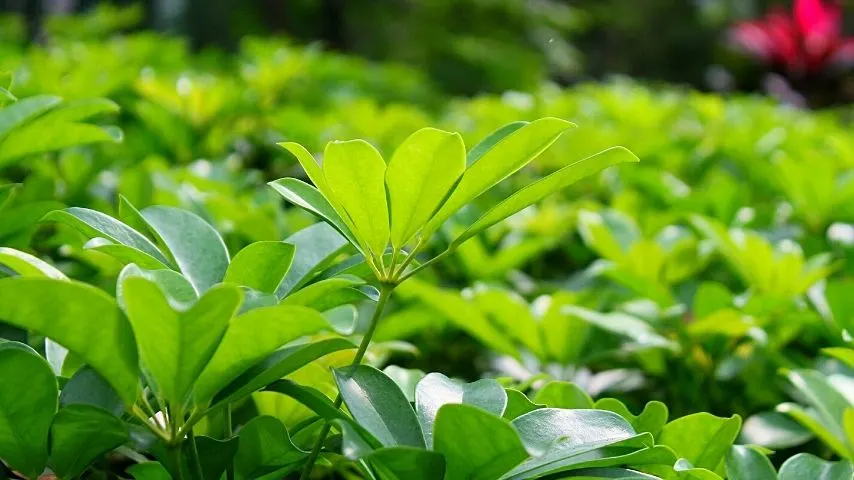
Schefflera Soleil is a popular chartreuse plant grown for its stunning leaves that would look breathtaking surrounded by other greener plants.
This plant can survive under indirect sunlight or even low lighting, making it perfect for bathrooms.
Schefflera Soleil has simple-looking leaves, but their color is what makes everyone’s head turn.
While this plant mostly grows chartreuse-colored leaves, it can also grow leaves with hints of dark green color in it as well.
This stunning plant can grow up to 12 feet tall (3 meters tall) or be kept smaller, around 6 inches (1.8 meters) if occasionally pruned.
Schefflera Soleil plants binomial nomenclature and basic plant care requirements include:
- Temperature: around 55° to 75°F (12°-to-24°C)
- pH: 6 – 6.0
- Soil: requires rich, loose, well-drained potting soil
- Fertilizer: use a diluted fertilizer once a month from spring to fall
- Growth rate: moderate growth
- Humidity: average household humidity or higher
- Scientific name: Schefflera arboricola
- Common name: Umbrella Plant Lemon
Conclusion
Low-lighting plants may not need a lot of sunlight, but they have other demands that need to be fulfilled to thrive.
If you have a bathroom with absolutely no lighting to help your plants grow and wish to grow plants with higher lighting demands.
Then, it’s a good idea to invest in grow lights as all plants require just a tiny bit of sunlight to survive.

Daniel has been a plant enthusiast for over 20 years. He owns hundreds of houseplants and prepares for the chili growing seasons yearly with great anticipation. His favorite plants are plant species in the Araceae family, such as Monstera, Philodendron, and Anthurium. He also loves gardening and is growing hot peppers, tomatoes, and many more vegetables.

![30 Best Plants for Bathroom With No Light – Top List [2024]](https://plantophiles.com/wp-content/uploads/2022/05/30-Best-Plants-for-Bathrooms-With-No-Light-720x405.jpg.webp)
